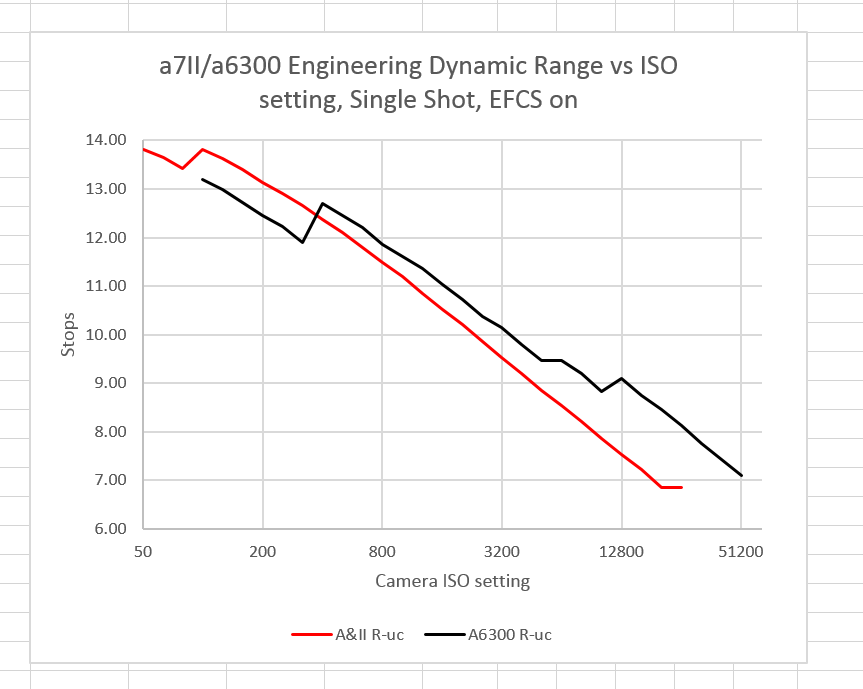This is part of a long series of posts about the Sony a6300. The series starts here.
I’ve received a request for some context on some of the a6300 graphs I’ve been posting. I’m pleased to respond. Let’s compare the engineering dynamic range of the a6300 to its Sony stablemate, the a7II.
In one sense, it’s a fair comparison. Both are 24 MP cameras, so there’s no need to scale the results to level the resolution playing field. And, here’s the bottom line: at ISOs of 400 and above, the a6300 comes out the winner, thanks to the dual conversion gain trick.
I wouldn’t expect the photographic dynamic range (PDR) to be so even, though, since I suspect the full well capacity of the full frame a7II is higher than its APS-C cousin, and photon noise is usually more important than read noise for PDR..
Still, credit where credit is due. Good job, Sony.
By the way, as I’ve mentioned before, the a6300 shouldn’t get any credit for the boost in EDR that happens above ISO 10000. The camera achieves that bump through the highly-dubious trick of digital low-pass filtering.

hi jim
what about a third and fourth curve overlay of the a7s and a7r ii?
would be interesting comparo. the a6300 seems to perform better or on par with other sensor manufactors full frame offerings – look at the “new” panasonic sensor used in the leica q or sl… one can see this a bit when reviewing the studio scene of dpr when comparing the fuji pro 2 (a6300 sensor) with the leica q.
kind regards,
matthias
That would require either (sometimes controversial) compensatory mathematical correction, or a long-winded explanation, since the two cameras you mentioned have different resolution than the a7II/a6300.
Jim
What do you mean by the full well capacity being better improving the dynamic range on the A7?
Do you mean that while the circuitry induced noise that dominates in the deep shadows is roughly equal, but the noise in the midtones caused by shot noise will be better for the full frame camera? (Since shot noise SNR drops half a stop for each stop brighter, rather than the full stop decrease in electronics noise per stop brighter)
In which case, dynamic range will still be about the same, being limited by the shadows but the full frame camera will deliver an overall cleaner image.
I was making a distinction between engineering dynamic range (EDR), and photographic dynamic range (PDR). EDR = fullscale / noise floor. PDR is fullscale divided by whatever relative exposure gives an acceptable signal to noise ratio.
http://blog.kasson.com/?p=8259
http://blog.kasson.com/?p=8280
Jim
PS I’ve edited the original post to make the point you raise clearer. Thanks.
Some of this discussion, including EDR vs. PDR, is over my head. In layman’ terms, am I correct in interpreting that below 400 ISO, the files from the A7 II, in 14-bit mode, can be pushed harder than the files from the A6300, in 14-bit mode?
My question above has been answered in the thread below:
https://www.dpreview.com/forums/thread/3980120?page=2